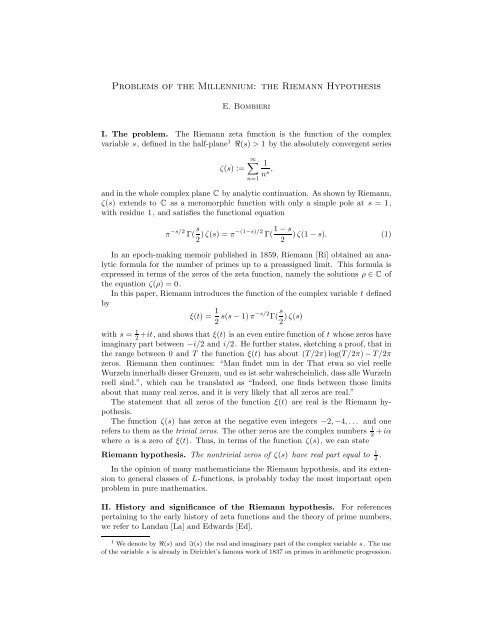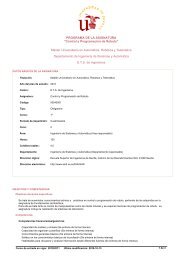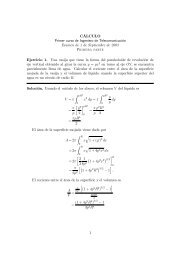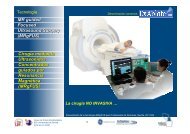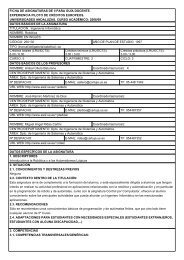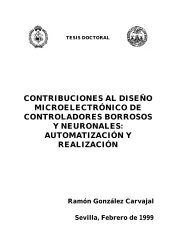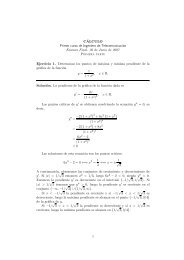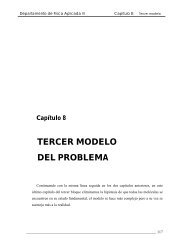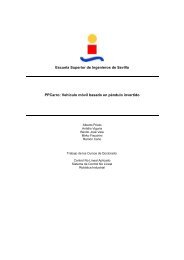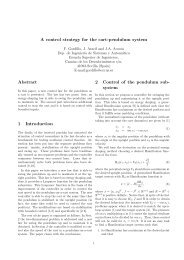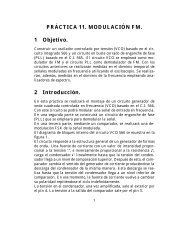the Riemann Hypothesis - Clay Mathematics Institute
the Riemann Hypothesis - Clay Mathematics Institute
the Riemann Hypothesis - Clay Mathematics Institute
Create successful ePaper yourself
Turn your PDF publications into a flip-book with our unique Google optimized e-Paper software.
Problems of <strong>the</strong> Millennium: <strong>the</strong> <strong>Riemann</strong> Hypo<strong>the</strong>sisE. BombieriI. The problem. The <strong>Riemann</strong> zeta function is <strong>the</strong> function of <strong>the</strong> complexvariable s, defined in <strong>the</strong> half-plane 1 R(s) > 1 by <strong>the</strong> absolutely convergent seriesζ(s) :=∞∑n=11n s ,and in <strong>the</strong> whole complex plane C by analytic continuation. As shown by <strong>Riemann</strong>,ζ(s) extends to C as a meromorphic function with only a simple pole at s =1,with residue 1, and satisfies <strong>the</strong> functional equationπ −s/2 Γ( s 2 ) ζ(s) =π−(1−s)/2 Γ( 1 − s ) ζ(1 − s). (1)2In an epoch-making memoir published in 1859, <strong>Riemann</strong> [Ri] obtained an analyticformula for <strong>the</strong> number of primes up to a preassigned limit. This formula isexpressed in terms of <strong>the</strong> zeros of <strong>the</strong> zeta function, namely <strong>the</strong> solutions ρ ∈ C of<strong>the</strong> equation ζ(ρ) =0.In this paper, <strong>Riemann</strong> introduces <strong>the</strong> function of <strong>the</strong> complex variable t definedbyξ(t) = 1 2 s(s − 1) π−s/2 Γ( s 2 ) ζ(s)with s = 1 2+it, and shows that ξ(t) is an even entire function of t whose zeros haveimaginary part between −i/2 andi/2. He fur<strong>the</strong>r states, sketching a proof, that in<strong>the</strong> range between 0 and T <strong>the</strong> function ξ(t) has about (T/2π)log(T/2π) − T/2πzeros. <strong>Riemann</strong> <strong>the</strong>n continues: “Man findet nun in der That etwa so viel reelleWurzeln innerhalb dieser Grenzen, und es ist sehr wahrscheinlich, dass alle Wurzelnreell sind.”, which can be translated as “Indeed, one finds between those limitsabout that many real zeros, and it is very likely that all zeros are real.”The statement that all zeros of <strong>the</strong> function ξ(t) are real is <strong>the</strong> <strong>Riemann</strong> hypo<strong>the</strong>sis.The function ζ(s) has zeros at <strong>the</strong> negative even integers −2, −4,... and onerefers to <strong>the</strong>m as <strong>the</strong> trivial zeros. The o<strong>the</strong>r zeros are <strong>the</strong> complex numbers 1 2 + iαwhere α is a zero of ξ(t). Thus, in terms of <strong>the</strong> function ζ(s), we can state<strong>Riemann</strong> hypo<strong>the</strong>sis. The nontrivial zeros of ζ(s) have real part equal to 1 2 .In <strong>the</strong> opinion of many ma<strong>the</strong>maticians <strong>the</strong> <strong>Riemann</strong> hypo<strong>the</strong>sis, and its extensionto general classes of L-functions, is probably today <strong>the</strong> most important openproblem in pure ma<strong>the</strong>matics.II. History and significance of <strong>the</strong> <strong>Riemann</strong> hypo<strong>the</strong>sis. For referencespertaining to <strong>the</strong> early history of zeta functions and <strong>the</strong> <strong>the</strong>ory of prime numbers,we refer to Landau [La] and Edwards [Ed].1 We denote by R(s) andI(s) <strong>the</strong> real and imaginary part of <strong>the</strong> complex variable s . The useof <strong>the</strong> variable s is already in Dirichlet’s famous work of 1837 on primes in arithmetic progression.
2 E. BOMBIERIThe connection between prime numbers and <strong>the</strong> zeta function, by means of <strong>the</strong>celebrated Euler productζ(s) = ∏ (1 − p −s ) −1pvalid for R(s) > 1, appears for <strong>the</strong> first time in Euler’s book Introductio in AnalysinInfinitorum, published in 1748. Euler also studied <strong>the</strong> values of ζ(s) at <strong>the</strong> evenpositive and <strong>the</strong> negative integers, and he divined a functional equation, equivalentto <strong>Riemann</strong>’s functional equation, for <strong>the</strong> closely related function ∑ (−1) n−1 /n s(see <strong>the</strong> interesting account of Euler’s work in Hardy’s book [Hard]).The problem of <strong>the</strong> distribution of prime numbers received attention for <strong>the</strong> firsttime with Gauss and Legendre, at <strong>the</strong> end of <strong>the</strong> eighteenth century. Gauss, in aletter to <strong>the</strong> astronomer Hencke in 1849, stated that he had found in his early yearsthat <strong>the</strong> number π(x) ofprimesuptox is well approximated by <strong>the</strong> function 2∫ xdtLi(x) =0 log t .In 1837, Dirichlet proved his famous <strong>the</strong>orem of <strong>the</strong> existence of infinitely manyprimes in any arithmetic progression qn+a with q and a positive coprime integers.On May 24, 1848, Tchebychev read at <strong>the</strong> Academy of St. Petersburg his firstmemoir on <strong>the</strong> distribution of prime numbers, later published in 1850. It contains<strong>the</strong> first study of <strong>the</strong> function π(x) by analytic methods. Tchebychev begins bytaking <strong>the</strong> logarithm of <strong>the</strong> Euler product, obtaining 3− ∑ plog(1 − 1 p s ) + log(s − 1) =log ( (s − 1)ζ(s) ) , (2)which is his starting point.Next, he proves <strong>the</strong> integral formulaζ(s) − 1 − 1s − 1 = 1 ∫ ∞1(Γ(s) 0 e x − 1 − 1 x ) e−x x s−1 dx, (3)out of which he deduces that (s − 1)ζ(s) has limit 1, and also has finite derivativesof any order, as s tends to 1 from <strong>the</strong> right. He <strong>the</strong>n observes that <strong>the</strong> derivativesof any order of <strong>the</strong> left-hand side of (2) can be written as a fraction in which <strong>the</strong>numerator is a polynomial in <strong>the</strong> derivatives of (s − 1)ζ(s), and <strong>the</strong> denominatoris an integral power of (s − 1)ζ(s), from which it follows that <strong>the</strong> left-hand side of(2) has finite derivatives of any order, as s tends to 1 from <strong>the</strong> right. From this,he is able to prove that if <strong>the</strong>re is an asymptotic formula for π(x) bymeansofafinite sum ∑ a k x/(log x) k ,uptoanorderO(x/(log x) N ), <strong>the</strong>n a k =(k − 1)! fork =1,... ,N− 1. This is precisely <strong>the</strong> asymptotic expansion of <strong>the</strong> function Li(x),thus vindicating Gauss’s intuition.A second paper by Tchebychev gave rigorous proofs of explicit upper and lowerbounds for π(x), of <strong>the</strong> correct order of magnitude. Here, he introduces <strong>the</strong> countingfunctionsϑ(x) = ∑ log p,p≤xψ(x) =ϑ(x)+ϑ( 2√ x)+ϑ( 3√ x)+...2 The integral is a principal value in <strong>the</strong> sense of Cauchy.3 Tchebychev uses 1 + ρ in place of our s . We write his formulas in modern notation.
PROBLEMS OF THE MILLENNIUM: THE RIEMANN HYPOTHESIS 3and proves <strong>the</strong> identity 4∑ψ( x n )=log[x]! .n≤xFrom this identity, he finally obtains numerical upper and lower bounds for ψ(x),ϑ(x) andπ(x).Popular variants of Tchebychev’s method, based on <strong>the</strong> integrality of suitableratios of factorials, originate much later and cannot be ascribed to Tchebychev.<strong>Riemann</strong>’s memoir on π(x) is really astonishing for <strong>the</strong> novelty of ideas introduced.He first writes ζ(s) using <strong>the</strong> integral formula, valid for R(s) > 1:ζ(s) = 1 ∫ ∞e −xΓ(s) 0 1 − e −x xs−1 dx, (4)and <strong>the</strong>n deforms <strong>the</strong> contour of integration in <strong>the</strong> complex plane, so as to obtaina representation valid for any s. This gives <strong>the</strong> analytic continuation and <strong>the</strong>functional equation of ζ(s). Then he gives a second proof of <strong>the</strong> functional equationin <strong>the</strong> symmetric form (1), introduces <strong>the</strong> function ξ(t) and states some of itsproperties as a function of <strong>the</strong> complex variable t.<strong>Riemann</strong> continues by writing <strong>the</strong> logarithm of <strong>the</strong> Euler product as an integraltransform, valid for R(s) > 1:∫1∞s log ζ(s) =1∏(x)x −s−1 dx (5)where∏ 1(x) =π(x)+2 π( 2√ x)+ 1 3 π( 3√ x)+... .By Fourier inversion, he is able to express ∏ (x) as a complex integral, and computeit using <strong>the</strong> calculus of residues. The residues occur at <strong>the</strong> singularities of log ζ(s)at s =1 and at <strong>the</strong> zeros of ζ(s). Finally an inversion formula expressing π(x) interms of ∏ (x) yields <strong>Riemann</strong>’s formula.This was a remarkable achievement which immediately attracted much attention.Even if <strong>Riemann</strong>’s initial line of attack may have been influenced by Tchebychev(we find several explicit references to Tchebychev in <strong>Riemann</strong>’s unpublished Nachlass5 ) his great contribution was to see how <strong>the</strong> distribution of prime numbers isdetermined by <strong>the</strong> complex zeros of <strong>the</strong> zeta function.At first sight, <strong>the</strong> <strong>Riemann</strong> hypo<strong>the</strong>sis appears to be only a plausible interestingproperty of <strong>the</strong> special function ζ(s), and <strong>Riemann</strong> himself seems to take that view.He writes: “Hiervon wäre allerdings ein strenger Beweis zu wünschen; ich habeindess die Aufsuchung desselben nach einigen flüchtigen vergeblichen Versuchenvorläufig bei Seite gelassen, da er für den nächsten Zweck meiner Untersuchungentbehrlich schien.”, which can be translated as “Without doubt it would be desirableto have a rigorous proof of this proposition; however I have left this researchaside for <strong>the</strong> time being after some quick unsuccessful attempts, because it appearsto be unnecessary for <strong>the</strong> immediate goal of my study.”4 Here [x] denotes <strong>the</strong> integral part of x.5 The Nachlass consists of <strong>Riemann</strong>’s unpublished notes and is preserved in <strong>the</strong> ma<strong>the</strong>maticallibrary of <strong>the</strong> University of Göttingen. The part regarding <strong>the</strong> zeta function was analyzed in depthby C.L. Siegel [Sie].
PROBLEMS OF THE MILLENNIUM: THE RIEMANN HYPOTHESIS 5of Wiles [Wi] and Taylor and Wiles [TW] leading to <strong>the</strong> solution of Fermat’s LastTheorem, and <strong>the</strong>n in <strong>the</strong> general case in a recent preprint by Breuil, Conrad,Diamond and Taylor.Not all L-functions are directly associated to arithmetic or geometric objects.The simplest example of L-functions not of arithmetic/geometric nature are thosearising from Maass waveforms for a <strong>Riemann</strong> surface X uniformized by an arithmeticsubgroup Γ of PGL(2, R). They are pull-backs f(z), to <strong>the</strong> universal coveringspace I(z) > 0 of X , of simultaneous eigenfunctions for <strong>the</strong> action of <strong>the</strong>hyperbolic Laplacian and of <strong>the</strong> Hecke operators on X .The most important case is again <strong>the</strong> group Γ 0 (N). In this case one can introducea notion of primitive waveform, analogous to <strong>the</strong> notion of primitive Dirichletcharacter, meaning that <strong>the</strong> waveform is not induced from ano<strong>the</strong>r waveform for aΓ 0 (N ′ ) with N ′ a proper divisor of N . For a primitive waveform, <strong>the</strong> action of<strong>the</strong> Hecke operators T n is defined for every n and <strong>the</strong> L-function can be definedas ∑ λ f (n)n −s where λ f (n) is <strong>the</strong> eigenvalue of T n acting on <strong>the</strong> waveform f(z).Such an L-function has an Euler product and satisfies a functional equation analogousto that for ζ(s). It is also expected that it satisfies a <strong>Riemann</strong> hypo<strong>the</strong>sis.Not a single example of validity or failure of a <strong>Riemann</strong> hypo<strong>the</strong>sis for an L-function is known up to this date. The <strong>Riemann</strong> hypo<strong>the</strong>sis for ζ(s) does not seemto be any easier than for Dirichlet L-functions (except possibly for non-trivialreal zeros), leading to <strong>the</strong> view that its solution may require attacking much moregeneral problems, by means of entirely new ideas.III. Evidence for <strong>the</strong> <strong>Riemann</strong> hypo<strong>the</strong>sis. Notwithstanding some skepticismvoiced in <strong>the</strong> past, based perhaps more on <strong>the</strong> number of failed attempts to aproof ra<strong>the</strong>r than on solid heuristics, it is fair to say that today <strong>the</strong>re is quite abit of evidence in its favor. We have already emphasized that <strong>the</strong> general <strong>Riemann</strong>hypo<strong>the</strong>sis is consistent with our present knowledge of number <strong>the</strong>ory. There isalso specific evidence of a more direct nature, which we shall now examine.First, strong numerical evidence.Interestingly enough, <strong>the</strong> first numerical computation of <strong>the</strong> first few zeros of<strong>the</strong> zeta function already appears in <strong>Riemann</strong>’s Nachlass. A rigorous verification of<strong>the</strong> <strong>Riemann</strong> hypo<strong>the</strong>sis in a given range can be done numerically as follows. Thenumber N(T ) of zeros of ζ(s) in <strong>the</strong> rectangle R with vertices at −1 − iT, 2 −iT, 2+iT, −1+iT is given by Cauchy’s integralN(T ) − 1= 1 ∫− ζ′2πi ∂R ζ (s)ds,provided T is not <strong>the</strong> imaginary part of a zero (<strong>the</strong> −1 in <strong>the</strong> left-hand side ofthis formula is due to <strong>the</strong> simple pole of ζ(s) at s =1). The zeta function andits derivative can be computed to arbitrary high precision using <strong>the</strong> MacLaurinsummation formula or <strong>the</strong> <strong>Riemann</strong>-Siegel formula [Sie]; <strong>the</strong> quantity N(T ) − 1,which is an integer, is <strong>the</strong>n computed exactly by dividing by 2πi <strong>the</strong> numericalevaluation of <strong>the</strong> integral, and rounding off its real part to <strong>the</strong> nearest integer (thisis only of <strong>the</strong>oretical interest and much better methods are available in practice forcomputing N(T ) exactly). On <strong>the</strong> o<strong>the</strong>r hand, since ξ(t) is continuous and realfor real t, <strong>the</strong>re will be a zero of odd order between any two points at which ξ(t)changes sign. By judiciously choosing sample points, one can detect sign changes
PROBLEMS OF THE MILLENNIUM: THE RIEMANN HYPOTHESIS 7defined over F q , in o<strong>the</strong>r words formal finite sums a = ∑ a i P i with a i ∈ Z andP i points of C defined over a finite extension of F q , such that φ(a) =a where φis <strong>the</strong> Frobenius endomorphism on C raising coordinates to <strong>the</strong> q -th power. Thequantity deg(a) = ∑ a i is <strong>the</strong> degree of <strong>the</strong> divisor a. The divisor a is calledeffective if every a i is a positive integer; in this case, we write a > 0. Finally, aprime divisor p is a positive divisor which cannot be expressed as <strong>the</strong> sum of twopositive divisors. By definition, <strong>the</strong> norm of a divisor a is Na = q deg(a) .The zeta function of <strong>the</strong> curve C ,asdefinedbyE.Artin,H.HasseandF.K.Schmidt, isζ(s, C) = ∑ 1Na s .a>0This function has an Euler productζ(s, C) = ∏ p(1 − Np −s ) −1and a functional equationq (g−1)s ζ(s, C) =q (g−1)(1−s) ζ(1 − s, C)where g is <strong>the</strong> genus of <strong>the</strong> curve C ; it is a consequence of <strong>the</strong> <strong>Riemann</strong>-Roch<strong>the</strong>orem. The function ζ(s, C) is a rational function of <strong>the</strong> variable t = q −s ,hence is periodic 7 with period 2πi/ log q , and has simple poles at <strong>the</strong> points s =2πim/ log q and s =1+2πim/ log q for m ∈ Z. Expressed in terms of <strong>the</strong> variablet, <strong>the</strong> zeta function becomes a rational function Z(t, C) oft, with simple poles att =1andt = q −1 . The use of <strong>the</strong> variable t, ra<strong>the</strong>r than q −s , is more natural in<strong>the</strong> geometric case and we refer to Zeta functions, with a capital Z, to indicate <strong>the</strong>corresponding objects.The <strong>Riemann</strong> hypo<strong>the</strong>sis for ζ(s, C) is <strong>the</strong> statement that all its zeros have realpart equal to 1 2; in terms of <strong>the</strong> Zeta function Z(t, C), which has a numerator ofdegree 2g , has zeros of absolute value q − 1 2 .This is easy to verify if g =0, because <strong>the</strong> numerator is 1. If g =1, a proofwas obtained by Hasse in 1934. The general case of arbitrary genus g was finallysettled by Weil in <strong>the</strong> early 1940s (see his letter to E. Artin of July 10, 1942 wherehe gives a complete sketch of <strong>the</strong> <strong>the</strong>ory of correspondences on a curve [We1]); hisresults were eventually published in book form in 1948 [We2].Through his researches, Weil was led to <strong>the</strong> formulation of sweeping conjecturesabout Zeta functions of general algebraic varieties over finite fields, relating <strong>the</strong>irproperties to <strong>the</strong> topological structure of <strong>the</strong> underlying algebraic variety. Here<strong>the</strong> <strong>Riemann</strong> hypo<strong>the</strong>sis, in a simplified form, is <strong>the</strong> statement that <strong>the</strong> reciprocalsof <strong>the</strong> zeros and poles of <strong>the</strong> Zeta function (<strong>the</strong> so-called characteristic roots) haveabsolute value q d/2 with d a positive integer or 0, and are interpreted as eigenvaluesof <strong>the</strong> Frobenius automorphism acting on <strong>the</strong> cohomology of <strong>the</strong> variety. AfterM. Artin, A. Gro<strong>the</strong>ndieck and J.-L. Verdier developed <strong>the</strong> fundamental tool ofétale cohomology, <strong>the</strong> proof of <strong>the</strong> corresponding <strong>Riemann</strong> hypo<strong>the</strong>sis for Zetafunctions of arbitrary varieties over finite fields was finally obtained by Deligne[Del1], [Del2]. Deligne’s <strong>the</strong>orem surely ranks as one of <strong>the</strong> crowning achievements7 Similarly, ζ(s) is almost periodic in any half-plane R(s) ≥ 1+δ , δ>0.
8 E. BOMBIERIof twentieth century ma<strong>the</strong>matics. Its numerous applications to <strong>the</strong> solution of longstandingproblems in number <strong>the</strong>ory, algebraic geometry and discrete ma<strong>the</strong>maticsare witness to <strong>the</strong> significance of <strong>the</strong>se general <strong>Riemann</strong> hypo<strong>the</strong>ses.In our opinion, <strong>the</strong>se results in <strong>the</strong> geometric setting cannot be ignored as notrelevant to <strong>the</strong> understanding of <strong>the</strong> classical <strong>Riemann</strong> hypo<strong>the</strong>sis; <strong>the</strong> analogiesare too compelling to be dismissed outright.V. Fur<strong>the</strong>r evidence: <strong>the</strong> explicit formula. A conceptually important generalizationof <strong>Riemann</strong>’s explicit formula for π(x), obtained by Weil [We3] in 1952,offers a clue to what may lie still undiscovered behind <strong>the</strong> problem.Consider <strong>the</strong> class W of complex-valued functions f(x) on <strong>the</strong> positive half-lineR + , continuous and continuously differentiable except for finitely many points atwhich both f(x) andf ′ (x) have at most a discontinuity of <strong>the</strong> first kind, and atwhich <strong>the</strong> value of f(x) andf ′ (x) is defined as <strong>the</strong> average of <strong>the</strong> right and leftlimits <strong>the</strong>re. Suppose also that <strong>the</strong>re is δ>0 such that f(x) =O(x δ )asx → 0+and f(x) =O(x −1−δ )asx → +∞.Let ˜f(s) be <strong>the</strong> Mellin transform˜f(s) =∫ ∞0f(x) x s dxx ,which is an analytic function of s for −δ
PROBLEMS OF THE MILLENNIUM: THE RIEMANN HYPOTHESIS 9Weil also proved that <strong>the</strong> <strong>Riemann</strong> hypo<strong>the</strong>sis is equivalent to <strong>the</strong> negativity of<strong>the</strong> right-hand side for all functions f(x) oftypef(x) =∫ ∞0g(xy) g(y)dy,whenever g ∈W satisfies <strong>the</strong> additional conditions∫ ∞0g(x) dxx∫ ∞= g(x)dx =0.In <strong>the</strong> geometric case of curves over a finite field, this negativity is a ra<strong>the</strong>r easyconsequence of <strong>the</strong> algebraic index <strong>the</strong>orem for surfaces, namely:Algebraic Index Theorem. Let X be a projective nonsingular surface definedover an algebraically closed field. Then <strong>the</strong> self-intersection quadratic form (D ·D),restricted to <strong>the</strong> group of divisors D on X of degree 0 in <strong>the</strong> projective embeddingof X , is negative semidefinite.The algebraic index <strong>the</strong>orem for surfaces is essentially due to Severi 8 in 1906[Sev,§2,Teo.I]. The proof uses <strong>the</strong> <strong>Riemann</strong>-Roch <strong>the</strong>orem on X and <strong>the</strong> finitenessof families of curves on X of a given degree; no o<strong>the</strong>r proof by algebraic methods isknown up to now, although much later several authors independently rediscoveredSeveri’s argument.The algebraic index <strong>the</strong>orem for nonsingular projective varieties of even dimensionover <strong>the</strong> complex numbers was first formulated and proved by Hodge, as aconsequence of his <strong>the</strong>ory of harmonic forms. No algebraic proof of Hodge’s <strong>the</strong>oremis known, and it remains a fundamental open problem to extend it to <strong>the</strong> caseof varieties over fields of positive characteristic.The work of Montgomery [Mo], Odlyzko [Od] and Rudnick and Sarnak [RS] oncorrelations for spacings of zeros of ξ(t) suggests that L-functions can be groupedinto a few families, in each of which <strong>the</strong> spacing correlation is universal; <strong>the</strong> conjecturedspacing correlation is <strong>the</strong> same as for <strong>the</strong> limiting distribution of eigenvaluesof random orthogonal, unitary or symplectic matrices in suitable universal families,as <strong>the</strong> dimension goes to ∞. All this is compatible with <strong>the</strong> view expressed byHilbert and Pólya that <strong>the</strong> zeros of ξ(t) could be <strong>the</strong> eigenvalues of a self-adjointlinear operator on an appropriate Hilbert space. It should also be noted that acorresponding unconditional <strong>the</strong>ory for <strong>the</strong> spacing correlations of characteristicroots of Zeta functions of families of algebraic varieties over a finite field, has beendeveloped by Katz and Sarnak [KS], using methods introduced by Deligne in hisproof of <strong>the</strong> <strong>Riemann</strong> hypo<strong>the</strong>sis for varieties over finite fields. Thus <strong>the</strong> problemof spacing correlations for zeros of L-functions appears to lie very deep.All this leads to several basic questions.Is <strong>the</strong>re a <strong>the</strong>ory in <strong>the</strong> global case, playing <strong>the</strong> same role as cohomology doesfor Zeta functions of varieties over a field of positive characteristic? Is <strong>the</strong>re ananalogue of a Frobenius automorphism in <strong>the</strong> classical case? Is <strong>the</strong>re a generalindex <strong>the</strong>orem by which one can prove <strong>the</strong> classical <strong>Riemann</strong> hypo<strong>the</strong>sis? We are8 Severi showed that a divisor D on X is algebraically equivalent to 0 up to torsion, if it hasdegree 0 and (D · D) = 0. His proof holds, without modifications, under <strong>the</strong> weaker assumption(D · D) ≥ 0, which yields <strong>the</strong> index <strong>the</strong>orem.0
10 E. BOMBIERIhere in <strong>the</strong> realm of conjectures and speculation. In <strong>the</strong> adelic setting propoundedby Tate and Weil, <strong>the</strong> papers [Conn], [Den], [Hara] offer glimpses of a possible setupfor <strong>the</strong>se basic problems.On <strong>the</strong> o<strong>the</strong>r hand, <strong>the</strong>re are L-functions, such as those attached to Maasswaveforms, which do not seem to originate from geometry and for which we stillexpect a <strong>Riemann</strong> hypo<strong>the</strong>sis to be valid. For <strong>the</strong>m, we do not have algebraic andgeometric models to guide our thinking, and entirely new ideas may be needed tostudy <strong>the</strong>se intriguing objects.<strong>Institute</strong> for Advanced Study, Princeton, NJ 08540References[Conn] A. Connes, Trace formula in noncommutative geometry and <strong>the</strong> zeros of<strong>the</strong> <strong>Riemann</strong> zeta function, Selecta Math. (NS) 5 (1999), 29–106.[Conr] J.B. Conrey, More than two fifths of <strong>the</strong> zeros of <strong>the</strong> <strong>Riemann</strong> zetafunction are on <strong>the</strong> critical line, J. reine angew. Math. 399 (1989), 1–26.[Del1] P. Deligne, La Conjecture de Weil I, Publications Math. IHES 43 (1974),273–308.[Del2] P. Deligne, La Conjecture de Weil II, Publications Math. IHES 52(1980), 137–252.[Den] C. Deninger, Some analogies between number <strong>the</strong>ory and dynamicalsystems on foliated spaces, Proc. Int. Congress Math. Berlin 1998, Vol. I, 163–186.[Ed] H.M. Edwards, <strong>Riemann</strong>’s Zeta Function, Academic Press, New York -London 1974.[Hara] S. Haran, Index <strong>the</strong>ory, potential <strong>the</strong>ory, and <strong>the</strong> <strong>Riemann</strong> hypo<strong>the</strong>sis,L-functions and Arithmetic, Durham 1990, LMS Lecture Notes 153 (1991), 257–270.[Hard] G.H. Hardy, Divergent Series, Oxford Univ. Press 1949, Ch. II, 23–26.[IS] H. Iwaniec and P. Sarnak, Perspectives on <strong>the</strong> Analytic Theory ofL-Functions, to appear in proceedings of <strong>the</strong> conference Visions 2000, TelAviv.[Iv] A. Ivič, The <strong>Riemann</strong> Zeta-Function - The Theory of <strong>the</strong> <strong>Riemann</strong> Zeta-Function with Applications, John Wiley & Sons Inc., New York - Chichester -Brisbane - Toronto - Singapore 1985.[KS] N.M. Katz and P. Sarnak, Random matrices, Frobenius eigenvaluesand monodromy, Amer. Math. Soc. Coll. Publ. 49, Amer. Math. Soc., ProvidenceRI 1999.[La] E. Landau, Primzahlen, Zwei Bd., IInd ed., with an Appendix by Dr.Paul T. Bateman, Chelsea, New York 1953.
PROBLEMS OF THE MILLENNIUM: THE RIEMANN HYPOTHESIS 11[Le] N. Levinson, More than one-third of <strong>the</strong> zeros of <strong>the</strong> <strong>Riemann</strong> zetafunctionare on σ =1/2, Adv. Math. 13 (1974), 383–436.[LRW] J. van de Lune, J.J. te Riele and D.T. Winter, On <strong>the</strong> zeros of<strong>the</strong> <strong>Riemann</strong> zeta function in <strong>the</strong> critical strip, IV, Math. of Comp. 46 (1986),667–681.[Mo] H.L. Montgomery, Distribution of <strong>the</strong> Zeros of <strong>the</strong> <strong>Riemann</strong> Zeta Function,Proceedings Int. Cong. Math. Vancouver 1974, Vol. I, 379–381.[Od] A.M. Odlyzko, Supercomputers and <strong>the</strong> <strong>Riemann</strong> zeta function, Supercomputing89: Supercomputing Structures & Computations, Proc. 4-th Intern.Conf. on Supercomputing, L.P. Kartashev and S.I. Kartashev (eds.), InternationalSupercomputing <strong>Institute</strong> 1989, 348–352.[Ri] B. <strong>Riemann</strong>, Ueber die Anzahl der Primzahlen unter einer gegebenenGrösse, Monat. der Königl. Preuss. Akad. der Wissen. zu Berlin aus der Jahre1859 (1860), 671–680; also, Gesammelte math. Werke und wissensch. Nachlass, 2.Aufl. 1892, 145–155.[RS] Z. Rudnick and P. Sarnak, Zeros of principal L-functions and randommatrix <strong>the</strong>ory, Duke Math. J. 82 (1996), 269–322.[Sel] A. Selberg, On <strong>the</strong> zeros of <strong>the</strong> zeta-function of <strong>Riemann</strong>, Der Kong.Norske Vidensk. Selsk. Forhand. 15 (1942), 59–62; also, Collected Papers, Springer-Verlag, Berlin - Heidelberg - New York 1989, Vol. I, 156–159.[Sev] F. Severi, Sulla totalità delle curve algebriche tracciate sopra una superficiealgebrica, Math. Annalen 62 (1906), 194–225.[Sie] C.L. Siegel, Über <strong>Riemann</strong>s Nachlaß zur analytischen Zahlen<strong>the</strong>orie,Quellen und Studien zur Geschichte der Ma<strong>the</strong>matik, Astronomie und Physik 2(1932), 45–80; also Gesammelte Abhandlungen, Springer-Verlag, Berlin - Heidelberg- New York 1966, Bd. I, 275–310.[Ti] E.C. Titchmarsh, The Theory of <strong>the</strong> <strong>Riemann</strong> Zeta Function, 2nded.revised by R.D. Heath-Brown, Oxford Univ. Press 1986.[TW] R. Taylor and A. Wiles, Ring <strong>the</strong>oretic properties of certain Heckealgebras, Annals of Math. 141 (1995), 553–572.[We1] A. Weil, Œuvres Scientifiques–Collected Papers, corrected 2nd printing,Springer-Verlag, New York - Berlin 1980, Vol. I, 280-298.[We2] A. Weil, Sur les Courbes Algébriques et les Variétés qui s’en déduisent,Hermann & C ie , Paris 1948.[We3] A. Weil, Sur les “formules explicites” de la théorie des nombres premiers,Meddelanden Från Lunds Univ. Mat. Sem. (dedié à M. Riesz), (1952), 252-265; also, Œuvres Scientifiques–Collected Papers, corrected 2nd printing, Springer-Verlag, New York - Berlin 1980, Vol. II, 48–61.[Wi] A. Wiles, Modular elliptic curves and Fermat’s Last Theorem, Annalsof Math. 141 (1995), 443–551.


